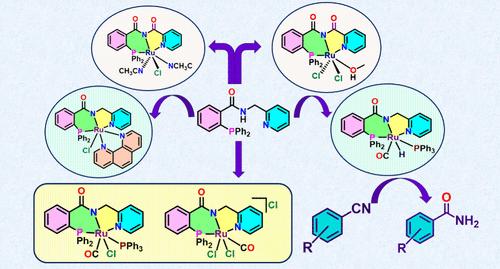面和经向pnn -钌螯合物在无碱丁腈水化中的协同配体主氧化
IF 4.7
2区 化学
Q1 CHEMISTRY, INORGANIC & NUCLEAR
引用次数: 0
摘要
采用三齿酰胺吡啶-单膦配体{(O - pph2)C6H4C(O)N(H)CH2(C5H4N)}(1)合成了一系列RuII和RuIII螯合物。配体1与[RuCl2(DMSO)4]和[RuCl2(PPh3)3]分别反应得到[RuCl(C12H8N2){(PNN)-κ3-P,N,N}](2)和[RuCl2(PPh3){(PNN)-κ3-P,N,N}](3),而与[RuHCl(CO)(PPh3)3]在不同条件下处理得到的螯合物[RuCl(CO)(PPh3){(PNN)-κ3-P,N,N}](4)、[RuH(CO)(PPh3){(PNN)-κ3-P,N,N}](5)和[Ru(Cl)2(CO){(PNN)-κ3-P,N,N}]Cl(6)。配体1与[Ru(p-伞花素)Cl2]2和[RuCl2(PPh3)3]在好氧条件下分别生成[RuCl(CH3CN)2{(O - pph2)C6H4C(O)NC(O)(C5H4N)}-κ3- p,N,N](7)和[RuCl2(CH3OH){(O - pph2)C6H4C(O)NC(O)(C5H4N)}-κ3- p,N,N](8)配合物,在室温下表现出无碱和无添加剂的苯基C-H氧化。配合物4和5用于丁腈与酰胺的水化反应。机理研究支持[Ru-H]活性物质通过[Ru-H···H-OH]二氢键促进水活化,从而对配位腈进行亲核攻击。该催化剂系统在低负荷下运行,可耐受富电子和缺电子腈。本文章由计算机程序翻译,如有差异,请以英文原文为准。

Facial and Meridional PNN-Ruthenium Pincer Complexes in Base-Free Nitrile Hydration with Concurrent Ligand Backbone Oxidation
A tridentate amide-pyridine-monophosphine ligand, {(o-PPh2)C6H4C(O)N(H)CH2(C5H4N)} (1), has been employed to synthesize a series of RuII and RuIII pincer complexes. Reaction of ligand 1 with [RuCl2(DMSO)4] and [RuCl2(PPh3)3] yielded [RuCl(C12H8N2){(PNN)-κ3-P,N,N}] (2) and [RuCl2(PPh3){(PNN)-κ3-P,N,N}] (3), respectively, while treatment with [RuHCl(CO)(PPh3)3] under varied conditions afforded pincer-type complexes [RuCl(CO)(PPh3){(PNN)-κ3-P,N,N}] (4), [RuH(CO)(PPh3){(PNN)-κ3-P,N,N}] (5), and [Ru(Cl)2(CO){(PNN)-κ3-P,N,N}]Cl (6). Ligand 1 upon reaction with [Ru(p-cymene)Cl2]2 and [RuCl2(PPh3)3] under aerobic reaction conditions afforded [RuCl(CH3CN)2{(o-PPh2)C6H4C(O)NC(O)(C5H4N)}-κ3-P,N,N] (7) and [RuCl2(CH3OH){(o-PPh2)C6H4C(O)NC(O)(C5H4N)}-κ3-P,N,N] (8) complexes, respectively, showing base- and additive-free benzylic C–H oxidation at room temperature. Complexes 4 and 5 were employed in the hydration of nitriles to amides. Mechanistic studies support a [Ru–H] active species facilitating water activation through a [Ru–H···H–OH] dihydrogen bond, enabling nucleophilic attack on the coordinated nitrile. The catalyst system operates at low loadings, tolerating both electron-rich and electron-deficient nitriles.
求助全文
通过发布文献求助,成功后即可免费获取论文全文。
去求助
来源期刊

Inorganic Chemistry
化学-无机化学与核化学
CiteScore
7.60
自引率
13.00%
发文量
1960
审稿时长
1.9 months
期刊介绍:
Inorganic Chemistry publishes fundamental studies in all phases of inorganic chemistry. Coverage includes experimental and theoretical reports on quantitative studies of structure and thermodynamics, kinetics, mechanisms of inorganic reactions, bioinorganic chemistry, and relevant aspects of organometallic chemistry, solid-state phenomena, and chemical bonding theory. Emphasis is placed on the synthesis, structure, thermodynamics, reactivity, spectroscopy, and bonding properties of significant new and known compounds.
 求助内容:
求助内容: 应助结果提醒方式:
应助结果提醒方式:


